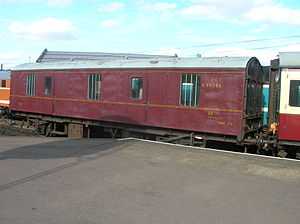Covered Carriage Truck
From Wikipedia, the free encyclopedia
| British Rail Covered Carriage Truck | |
|---|---|
 CCT No. 94286 preserved on the Great Central Railway | |
| In service | 1959–mid-1960s |
| Manufacturer |
BR Doncaster Works, BR Earlestown Works |
| Family name | British Railways Mark 1 |
| Constructed | 1959-1961 |
| Number built | 827 |
| Fleet numbers | 94100–94922, 96200–96203 |
| Capacity | 10 tonnes (9.8 long tons; 11.0 short tons) |
| Operator | British Rail |
| Specifications | |
| Car length | 23 ft 6 in (7.16 m)[1] |
| Width | 8 ft 9 in (2.67 m) |
| Height | 12 ft 6 in (3.81 m) |
| Maximum speed | 70 mph (113 km/h) |
| Weight | 17 tonnes (16.7 long tons; 18.7 short tons) |
| Track gauge | 4 ft 8 1⁄2 in (1,435 mm) |
Covered Carriage Truck was a type of railway van with end doors used for moving motor cars or parcel traffic. Four wheeled CCT were banned from Motorail services in the mid-1960s.[2] These vans were designed to be used for carrying motor cars in Motorail but the tight clearances inside the body of the van and closing/opening of the end doors took a lot of time and effort from staff. The vans were replaced by General Utility Vans (GUV) and car flats.[2]
References
- ↑ The Railway Centre, CCT data page
- ↑ 2.0 2.1 Railway Freight Operations - Non Passenger Coaching Stock - Private Carriages and Motor Cars
| |||||||||||||||||||||||||||
This article is issued from Wikipedia. The text is available under the Creative Commons Attribution/Share Alike; additional terms may apply for the media files.